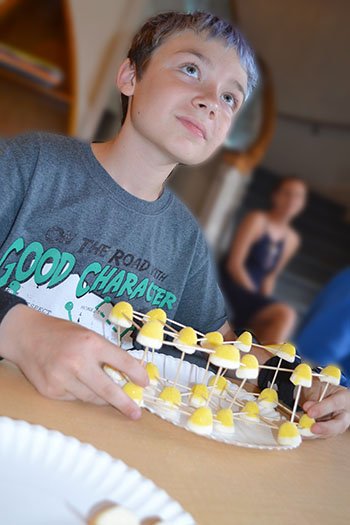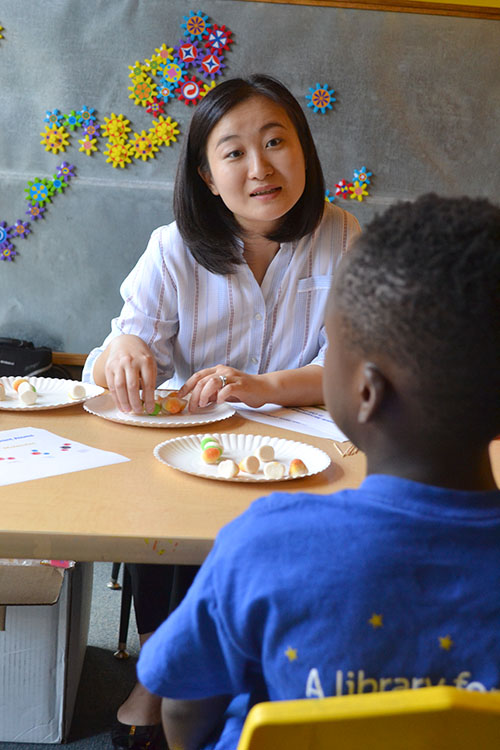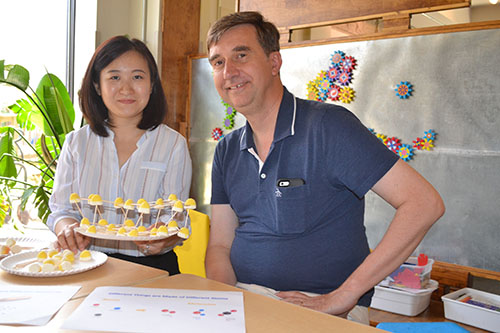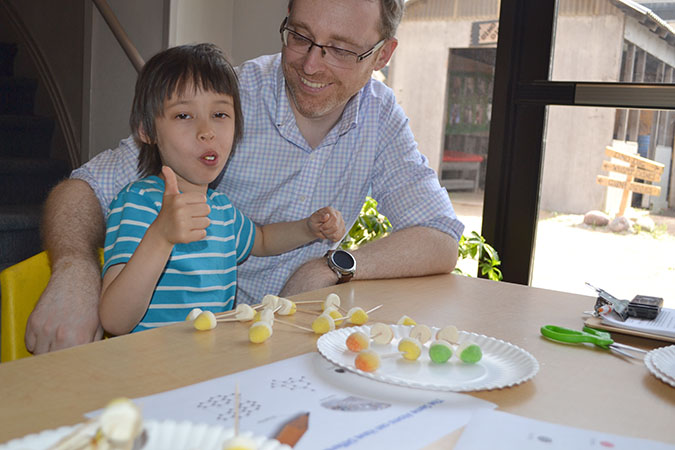Local Children “Make” Nanodiamond Molecules at the Orpheum Courtesy of MechSE Professor Lili Cai
July 1, 2019

Lili Cai discusses with a child how to arrange the gum drops to form the shape of a molecule.
While making a “molecule” with toothpicks and gum drops might just seem like a fun (and tasty?) pastime on a Saturday afternoon, the children participating in the activity at Champaign’s Orpheum Children’s Science Museum on June 29th were actually learning a bit about nanotechnology —to be specific—about nanodiamonds. The activity, presented by MechSE Assistant Professor Lili Cai, was related to one of her research areas: using a flame-based process to manufacture advanced nanomaterials. Cai is submitting an NSF Career grant proposal in January 2020, so in preparation, she has been implementing various research-related outreach activities that will fulfill NSF’s outreach component. For example, in addition to the June 29th nanodiamond activity, on July 11th, she’ll be presenting an activity to high school students participating in one of Illinois’ Worldwide Youth in Science and Engineering (WYSE) summer camps.

Lili Cai explains to a youngster about molecules.
Cai, who joined Mechanical Science and Engineering’s (MechSE’s) faculty early in the spring 2019 semester, explains that her research is very interdisciplinary. For example, in her focus on using a flame-based process to manufacture advanced nanomaterials, one of nanomaterial she’s making is nanodiamond. Using the flame environment she burns fuel in order to create a high temperature field. Reactive gas inside the flame contains carbon species that will grow from the bottom, atom by atom. This is the aspect of her research that's relevant to her outreach activities.

A local child makes a graphite molecule with the candy.
For instance, one goal of her activity was to help the kids understand how materials are made, and that different materials have different shapes made of different atoms. So she showed them the structure of common substances like air, water, and carbon dioxide, and finally a nanodiamond; then she had the kids use toothpicks to connect gum drops to make mock molecules.
The first part of the activity involved having the children use gum drops to build the molecular structures of some common materials. So first, they modelled air, water, and carbon dioxide. After starting with those simple structures, she then had them build the structures of graphite and diamond, “so that they will learn how things are different at small scale,” she explains.
Cai shares why events such as her outreach activity at the Orpheum are helpful for children. For one, she wants to inspire very young kids and to pique their interest in building things in hopes that that might get them interested in engineering.
“In engineering, a lot of times, we need to build new things,” she explains, “so I think that's kind of an activity that can inspire the children's interest into the mystery of how materials are made, and what the structure looks like, and then how the structure will affect the material properties.”

Lili Cai explains how to a child how to understand the difference in structures for different materials.
She shares a sort of mental flow chart.
“Basically, in building new materials, the common relation is that the process affects the structure of material, and then the structure determines the properties of the material, and then that will affect the performance. So basically, in this process, we expose the kids to one part of this relationship—the structure, and how the structure is different for different materials.”
Her overarching goal? To give the youngsters an idea of what research in engineering looks like. “Hopefully, they can develop an interest in building things,” she explains, “and then consider doing engineering in their education.”
While Cai has never done outreach like this before, she reports that she has been quite excited to see how it goes.
Helping Cai at the outreach MechSE's Education Coordinator, Joe Muskin. He shares about the impact he believes the outreach had on the youngsters at the Orpheum:

Lili Cai and Joe Muskin prepare to teach children at the Orpheum about different molecular structures, including graphite and diamond.
"It was great to see the kids start to think about atoms and molecules. Many have heard about “H2O” but didn’t know why that was another word for water. Talking about the atoms and how they combine to make molecules was often the first exposure these kids had to the concept, but they got it, they understood that things are made of small pieces that can combine to make other things. And the next time they encounter the idea of atoms and molecules, they will have a point of reference to build on!"
On July 11th, Cai is also scheduled to do an activity for high school students at the MechSE WYSE camp, where the students will basically be making their own ink, also related to her research. She will have students perform a sinkhole flame process using a candle flame to make a carbon black that could be used to make ink.
Author/Photographer: Elizabeth Innes, Communications Specialist, I-STEM Education Initiative
More: K-6 Outreach, Faculty Feature, MechSE, 2019
For additional I-STEM web articles about the MechSE, see:
- Mattia Gazzola’s Paper2Tree: A 3-Step Program to Give Back to Your Community: Publish a Paper ➜ Plant a Tree ➜ Perform a School Outreach
- MechSE’s Joe Muskin Enlightens Local Youngsters About 3D Printing During Champaign Public Library Event

Delicious snack rewards after completing the structures!













.jpg)
















